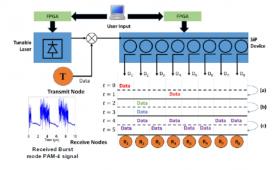A Software-Defined Photonic Chip with Advanced Switching Capabilities
A silicon-photonic chip, with its inherent advantages in speed and cost, was developed that can provide the variety of switching capabilities required in today’s data networks. Researchers at Columbia University—supported by the Center for Integrated Access Networks (CIAN), an NSF-funded Engineering Research Center (ERC) with headquarters at the University of Arizona—developed the new technology with a team from the Dublin City University Irish Photonic Integration Centre (IPIC).
While providing the building block of communications, the cross-bar functionality that allows simple switching of a signal between inputs and outputs, the new chip provides other switching functions such as broadcasting (one to all) or multicasting (one to several). The switch array was placed in a network and was controlled through a software-defined, networking-control plane.
Data centers continue to grow in scale, handling ever-increasing data traffic fueled by high demand for cloud-based services, video streams, and mobile devices. Demand for data is growing faster within the data centers than between centers, requiring expanding bandwidth between servers within centers that exceeds the capability of current Ethernet technology.
The needs can be met with switching equipment that employs optical technologies such as wavelength-division multiplexing and micro-opto-electro-mechanical systems, but such optical networks are not programmable today. CIAN’s chip shows software-defined networking photonics can meet the growing needs of tomorrow’s internet. Several rack shelves of gear have now been integrated into a single chip—moving optical switching from bulky components to highly scalable and less-expensive silicon-photonic chips.



